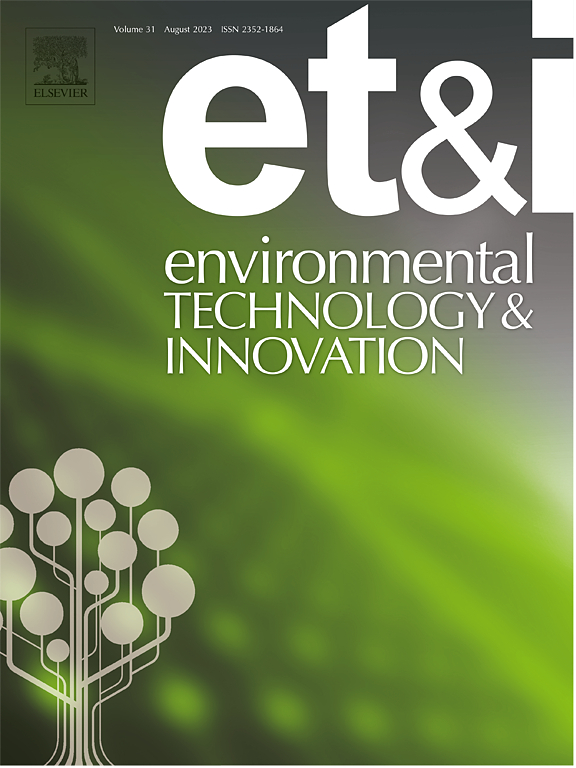牛粪及其生物炭修复多金属污染土壤:对小麦重金属吸收和土壤微生物组的影响
IF 6.7
2区 环境科学与生态学
Q1 BIOTECHNOLOGY & APPLIED MICROBIOLOGY
引用次数: 0
摘要
农业土壤多金属污染对小麦品质构成重大威胁。采用盆栽试验研究了牛粪(CD)和牛粪生物炭(CDB)对污染土壤小麦重金属吸收和微生物多样性的影响。施用CD和CDB可使土壤CD /Zn比降低30 %,抑制小麦根系对CD的吸收。与CK相比,CD剂量的0.5 % 1 %,和2 %谷物CD含量减少了12.7 %, % 37.0和35.3 %,分别和国开行剂量的0.05 %, % 0.1和0.2 %减少 % 16.7,27.7 %,分别和51.9 %。CD和CDB改变了土壤中HMs组分的分布,降低了酸萃取组分和Fe-Mn氧化组分的比例。土壤中Cd和Pb的酸可提取组分与pH呈显著负相关,证实pH升高会降低土壤中HMs的酸可提取组分。CD降低了土壤微生物α-多样性,但边、节点总数和微生物类群正相关比分别提高了168 %、34.5% %和9.97 %,使土壤微生物网络结构更加复杂和紧密。在1 %和2 %的剂量CD处理中出现了α变形菌、分枝杆菌和根瘤菌等特征微生物,氨基酸合成、有机物代谢和柠檬酸循环等代谢相关基因丰度上调,有利于土壤养分循环和转化。施用CD可以减少小麦对HMs的吸收,提高作物安全和土壤健康,促进生态友好型农业实践。本文章由计算机程序翻译,如有差异,请以英文原文为准。
Remediation of multi-metal contaminated soil using cow dung and its biochar: Effects on heavy metal uptake and soil microbiome in Triticum aestivum L
Multi-metals contamination in agriculture soil poses a significant challenge, threatening wheat quality. The effects of cow dung (CD) and cow dung biochar (CDB) applied to contaminated soil on heavy metals (HMs) uptake and microbial diversity in wheat were tested with pot experiment. CD and CDB applications reduced soil Cd/Zn ratio by 30 % and inhibited Cd uptake by wheat roots. Compared to the CK, CD doses of 0.5 %, 1 %, and 2 % reduced Cd content in grains by 12.7 %, 37.0 %, and 35.3 %, respectively, and CDB doses of 0.05 %, 0.1 %, and 0.2 % reduced it by 16.7 %, 27.7 %, and 51.9 %, respectively. CD and CDB changed the HMs fraction distribution in the soil and reduced the proportion of acid-extractable and Fe-Mn oxidized fractions. The significant negative correlation between the acid-extractable fractions of Cd and Pb in soil and pH, confirming that increased pH reduces the acid-extractable fraction of HMs in soils. CD reduced the α-diversity of soil microorganisms, but the total number of edges, nodes, and microbial taxa positive correlation ratio increased by 168 %, 34.5 %, and 9.97 %, respectively, resulting in more complex and tightly packed soil microbial network structure. Signature microorganisms such as Alphaproteobacteria, Mycobacterium spp. and Rhizobium spp. appeared in 1 % and 2 % of the dosage CD treatments, furthermore the abundance of metabolism-related genes such as amino acid synthesis, organic matter metabolism and citrate cycle were upregulated, which was favorable for soil nutrient cycling and transformation. Applying CD can mitigate wheat HMs uptake, improving crop safety and soil health and promoting eco-friendly agricultural practices.
求助全文
通过发布文献求助,成功后即可免费获取论文全文。
去求助
来源期刊

Environmental Technology & Innovation
Environmental Science-General Environmental Science
CiteScore
14.00
自引率
4.20%
发文量
435
审稿时长
74 days
期刊介绍:
Environmental Technology & Innovation adopts a challenge-oriented approach to solutions by integrating natural sciences to promote a sustainable future. The journal aims to foster the creation and development of innovative products, technologies, and ideas that enhance the environment, with impacts across soil, air, water, and food in rural and urban areas.
As a platform for disseminating scientific evidence for environmental protection and sustainable development, the journal emphasizes fundamental science, methodologies, tools, techniques, and policy considerations. It emphasizes the importance of science and technology in environmental benefits, including smarter, cleaner technologies for environmental protection, more efficient resource processing methods, and the evidence supporting their effectiveness.
 求助内容:
求助内容: 应助结果提醒方式:
应助结果提醒方式:


